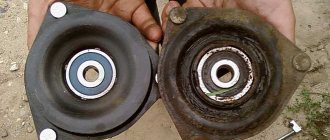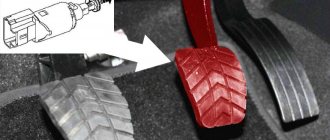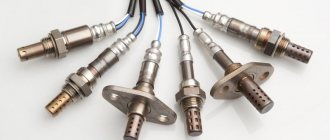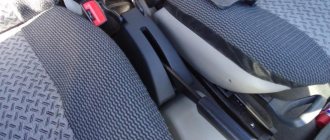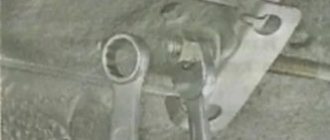In general, in practice, handbrake cables on Priora are changed extremely rarely. And if this is necessary, then in most cases for the following reasons:
- Over time, the cables stretch out, that is, they become longer. Accordingly, even with the lever fully raised, the effectiveness of the handbrake will be greatly reduced.
- Failure or complete rupture of the cable, which can occur during sudden braking using the handbrake (there are such amateurs), or when the lever is pulled too tightly for a long time.
If for one of the reasons you had to encounter a similar problem, then it must be solved by replacement. To do this we need the following tool:
- Long nose pliers
- Flat screwdriver
- Head for 7, 10 and 13 mm
- Ratchet or crank
- Extension
- Penetrating lubricant
What is a handbrake
The parking brake (in other words, the handbrake) is used to stop the car for a long time. It is used in parking lots, stops, on slopes and when maneuvering sharp turns. Such a car part can protect passengers and prevent accidents.
The hand brake is a safety system against unwanted movement. The operating principle is similar to a hydraulic system. In emergency situations, it is this type of vehicle design that ensures a complete stop of traffic.
How to use the handbrake correctly
Before starting to drive, you should check the position of the handbrake. If it is active, you cannot drive. This increases wear and causes problems with overheating of brake pads and discs. It is also not recommended to leave the handbrake active in winter. Due to the presence of dirt and snow on the asphalt, freezing of the above parts may occur. The car will not budge, and if force is applied, its individual mechanisms may break.
Parking brake design
Before deciding how to tension the cables and put them into operation, let’s consider the structural features of this system. There are two main elements of the handbrake:
- a lever that activates the brake;
- cables that work on the main braking system and slow down the movement.
There may be several cables in a car. Their number varies from one to three. The quantity depends on the Priora model. The most common option is with three cables. They are placed two at the back and one at the front. The “pair” is attached to the brake mechanism, and the third element is connected to the lever.
The connection of the cables is ensured by lugs that are adjustable. The design is also complemented by nuts placed at the ends of the “wires”. They are designed to change the length of the drive. The return spring ensures that the vehicle returns to its original position. It is located on the front cable and on the brake mechanism itself.
System operation process
- Move the brake lever to a vertical position until a locking sound appears.
- The cables move into a tensioned position.
- Locking the rear wheels for braking.
- Removing the handbrake to loosen the cables.
- Making the transition to driving mode.
Raising the handbrake on a Priora
It is not difficult to tighten this element of the brake system. Adjustment of the system requires the presence of only two keys for 13. It is desirable if they are open-end type. The process of self-repair is not difficult. For convenience, the repair process is carried out in a pit or using a lift - this makes it easier to get to the system. The photo shows a mechanism that requires intervention.
There is no need to lift the hatchback, just look under the car. The following workflow will look like this:
- Removing the heat shield.
- Loosening the lock nut.
- The first one needs to be tightened to the maximum level.
- Open cables are stretched.
- The nuts are tightened and the screen is installed in place.
Causes of malfunction and their elimination
As a rule, the reasons why the handbrake does not work are quite simple and do not require long or expensive repairs:
- torn cable. One of the common causes is a broken cable on the handbrake or under the car. The problem is solved by simply replacing the cable;
- jammed cable. Due to damage to the sheath in which the cable moves, it may become jammed, preventing you from using the handbrake. And the cable itself consists of many steel strands, which, if damaged, can also prevent proper operation. The solution is to replace the cable;
- dirty brakes. If dust, dirt, ice or reagents that are sprinkled on roads in winter get on the pads, this can cause the brakes to not work properly. The solution is to press the brake pedal several times smoothly while the car is moving. Thanks to friction, the pads will be cleaned;
- incorrect adjustment. It may happen that the cable system is not adjusted properly, the bolt is not tightened correctly, or the length of the cables is incorrectly selected. The solution is to adjust the system and correct tension of the cables;
- pad wear. The pads are subject to abrasion during operation. Every time you apply the brakes, the pads gradually become unusable. The solution is to replace the pads;
- oil in the pads. Oil or brake fluid leaks can cause the car to not hold up with the handbrake. The most important thing in this case is to identify the cause of the leak - it could be the rear axle seal or the brake cylinder. The solution is to eliminate the leak and clean the pads. If the pads are very oily, replace them.
Replacing parking brake cables on Lada Priora
You will need: a 10mm wrench, two 13mm wrenches, a large flat blade screwdriver.
1. Lower the parking brake lever all the way down.
2. On a car with ABS, remove the rear wheel speed sensor (see “Replacing wheel speed sensors”).
3. Remove the brake drum of the corresponding wheel (see “Removing and installing the rear wheel brake drum”) and the ABS impulse disc (on a vehicle with ABS).
4. Remove the muffler from the rubber suspension cushions of the exhaust system and the additional muffler from the rear cushion (see “Replacing the suspension cushions of the exhaust system”).
5. Remove the cable equalizer (see “Removing, installing the parking brake lever and replacing its drive rod”).
6. Remove the end of the cable sheath from the bracket on the body.
7. Bend the two cable fastening brackets.
8. Insert a screwdriver between the block and the parking brake lever, move the lever to the forward position and disconnect the cable end from the lever.
9. Loosen the nut securing the cable holder on the rear suspension beam and remove the cable from the holder.
10. Remove the cable from the bracket on the body.
11. Remove the cable from the brake shield.
12. Install the cable and all parts in the reverse order of removal. After installation, adjust the parking brake (see “Checking and adjusting the parking brake drive”).
Replacing the handbrake cable on a Priora with your own hands
All work must be performed with the rear of the car raised, using a jack, or carried out in an inspection pit. First, unscrew the nuts securing the protective heat shield and remove it as shown in the photo below:
Now, using a 13 mm socket and an extension, unscrew the nuts of the handbrake adjustment rod.
Then we remove the cables from the bar:
Now you need to pull the cable out of its seat, the one that needs to be replaced:
Next, you need to release the cable from the clamps at all points where it is attached to the Priora body.
And in other places where there are these brackets:
As a result, we should get something like the following picture:
Next, we proceed to release the cable from the wheel side. To do this, it is not necessary to remove the pads; you just need to remove the lower spring, and then use a flat-head screwdriver to move the cable drive lever to the side and remove the cable itself:
Basic faults
According to the law, a malfunction of the handbrake is accepted in two cases:
- If, at a 16% slope, the handbrake does not hold the equipped car (without cargo and passengers, but with a full tank of gasoline, the driver’s weight is taken to be 75 kg).
- If, on a 23% incline, the handbrake does not hold the vehicle at full load (the maximum permissible vehicle weight has been reached).
In reality, more often than not, a malfunction of this brake mechanism of the Lada Priora is noticed not by measuring the steepness of the slope, but by clicks. When another click of the handbrake is added to the usual “set of sounds” when leaving the car, every car enthusiast understands that it’s time to tighten the cable.
But the problems don't end there. For the parking brake system they can be as follows:
- The cable has stretched too far. Over time, it undergoes deformation. It can be tightened, but to a certain extent.
- The cable broke. When the “limit” is reached, the mechanical device will have to be replaced.
- The handbrake indicator on the dashboard does not light up or go off. This is due to the sensors.
- The lever button is stuck.
Parking brake lever repair
You will need: two 13mm wrenches, a 13mm socket wrench (head), a Phillips screwdriver, and pliers.
Operations performed when repairing the parking brake lever on a VAZ 2170 2171 2172 Lada Priora
The parking brake lever is a brake system and not only the operation of the brake system during parking, but also your safe movement depends on its serviceability. So, in particular, the rear brake pads are set using the hand brake; in the event of a malfunction of the hand brake system, the rear brakes may not be sufficiently effective.
You will need: two 13mm wrenches, a 13mm socket wrench (head), a Phillips screwdriver, and pliers.
Handbrake (parking brake) on Priora - article number and price
The assembled parking brake system of the Priora car has the catalog name “Handbrake drive” - number C170. Main components:
- cable bracket: 2108-03508214-20, 30 rubles;
- handbrake cable: 2110-03508180-01, price - 400 rubles;
- parking traction axis: 2110-03508073-00, price - 500 rubles;
- laying of parking rod 2110-03508089-00;
- parking drive rod: 2108-03508089-00, price - 250 rubles;
- parking brake lever (assembled): 2110-03508012-00, price - 600 rubles. Button – 2110-03508039-00;
- lever assembly with rod: 2110-03508010-00, price - 1300 rubles;
- traction protective cover: 2108-03508046-00, price – 40 rubles;
- cable equalizer: 2108-03508075-10, price – 50 rubles.
Removing elements of the parking brake system
We replace the parking brake cables when they are broken, pulled out, or stuck inside the sheaths, when adjusting the parking brake fails to keep the car stationary on a slope - up to 25% inclusive. We remove the parking brake lever to replace it or to replace the lever rod. The cables should be replaced simultaneously - left and right. We show the replacement of the left cable. Move the parking brake lever to its lowest position. We unscrew the locknut and the adjusting nut from the parking brake lever rod (see “Adjusting the parking brake”).
Remove the cable equalizer from the parking brake lever rod.
We take out the front cable ends from the equalizer and remove the equalizer.
Remove the end of the left cable sheath from the bracket.
The cables cross in front of the bracket.
Using a socket or a 10mm wrench, unscrew, not completely, the nut securing the bracket to the rear suspension beam... ...and remove the cable sheath from it.
We remove the cable sheath from the holder on the rear suspension beam mounting bracket.
Use a screwdriver to bend the bracket... ...and remove the cable from the holder on the body.
We remove the cable from the second holder located on the body in front of the fuel tank. Disconnect the rear end of the left cable from the parking brake drive lever (see “Replacing the rear wheel brake pads”).
We remove the cable tip from the hole in the brake shield... ...and remove the left cable. Similarly, remove the right parking cable cable. We install the cables in the reverse order. After replacing the cables, we adjust the parking brake (see “Adjusting the parking brake”). To remove the parking brake lever, unscrew the locknut and the adjusting nut from the parking brake lever rod (see “Adjusting the parking brake”). Remove the cable equalizer from the parking brake lever rod (see above). Remove the floor tunnel lining (see “Removing the floor tunnel lining”).
Using a 10mm socket, unscrew the four bolts securing the parking brake lever bracket to the floor tunnel.
Remove the parking brake lever with bracket and rod assembly, pulling the rod through the rubber sealing boot in the bottom of the body.
Using pliers, we straighten the cotter pin... ...and remove it from the finger.
Remove the washer, axle and rod from the parking brake lever. Install the parking brake lever in reverse order. We adjust the parking brake (see “Adjusting the parking brake”).
The manual or parking brake cable is the working part of the manual locking system for the rear wheels of a car. Cables connect the handbrake lever next to the driver and the brake elements of the rear wheels. Manual braking is used when parking with the engine turned off for more than 6 minutes or during emergency emergency braking on the road. The design of the hand brake is extremely simple and does not contain hydraulics.
The brake pads are actuated by cables twisted from individual steel wires. All this, lubricated with a special lubricant, is located in a shell, otherwise called a jacket. There are three cables in total: one central and two going to the rear wheels. According to the regulations, the cables last approximately 3 years. Over time, the cables stretch and, if adjustment does not help, you need to replace the Lada Priora parking brake cables.
practical guide
The need to replace the parking brake cables arises if the cables, as a result of corrosion, have lost the ability to move in the sheath, have become very stretched, or have broken threads.
If it is necessary to replace one of the cables, we also change the other cable.
Removing the parking brake cables:
1. We prepare the car for work.
2. Remove the brake drums.
3. Remove the protective screen.
4. Remove the rear protective screen.
5. Loosen the locknut of the parking brake lever stroke adjusting nut and unscrew the locknut.
6. Using a socket wrench with a 13 mm deep head and a cardan joint, unscrew the adjusting nut and remove it from the rod.
7. Remove the adjusting rod cable equalizer.
8. Disconnect the cable ends from the equalizer.
9. At the brake mechanism of the left rear wheel, use a large slotted screwdriver to move the spacer lever forward and remove the cable eyelet from the hook of the spacer lever.
10. Using a 10 mm spanner, unscrew the nut of the bracket securing the cable to the left arm of the rear suspension.
11. Remove the front cable end from the hole in the body bracket.
12. Remove the cable from the two brackets securing it to the underbody.
How to change the handbrake on a Priora - step-by-step guide
Replacing the handbrake cable is needed when a regular tightening is no longer an option; you will have to change the cable or drive. In order to replace the cable on a Priora car, prepare a Phillips screwdriver and a set of keys.
Replacing the cable is carried out as follows:
- Place the car in the pit, lower the handbrake, and engage the gear.
- Jack up the rear of the car, put supports on it, and remove the wheels. Further actions will be described on one side, they will need to be repeated on the other side.
- Loosen the main muffler and hang it up. Do the same with the resonator.
- Slightly loosen the handbrake rod locknut. Remove the cable equalizer.
- Remove the cable end by pulling it through the special bracket.
- Remove the brackets that hold the cable in place.
- Using a screwdriver, press down on the actuator lever to move it further away from the brake pad. The lever should move to the forward position. After this, you can disconnect the cable tip from the brake lever.
- Loosen the nut on the rear beam that holds the cable, and then pull it towards you.
- Pull the cable through the bracket that is attached to the body, then through the brake shield.
- Check the parking brake and make adjustments. If necessary, tighten the nut more.
In order to change the Priora handbrake lever, you will need a set of keys, pliers, and a Phillips screwdriver.
Carry out replacement work according to the following instructions:
- Drive the car into the pit. Remove the negative terminal from the battery.
- Remove the lining of the central tunnel in the cabin.
- At the bottom, remove the metal plate that covers the parking brake rod. Loosen the locknut and then remove the equalizer.
- Remove the protective cover from the hole in the floor.
- While in the cabin, unscrew the screw that secures the tidy handbrake indicator switch. This screw holds the indicator switch ground.
- Using a wrench, unscrew the bolts securing the handle under the casing.
- Pull the lever assembly towards you - up, then pull the rod behind it.
- The rod can be replaced; to do this, remove the cotter pin and washer. The rod will be free and can be replaced.
- Disconnect the rod and axle.
- Reassemble the handbrake drive in the reverse order of removal. After assembling the system, adjust the cable, achieving 2-4 clicks to fix the machine.
Replacing the handbrake cable on VAZ 2109 and 2110. We can do without a service station
- Jack;
- New handbrake cable;
- New repair kit for rubber bushings;
- Drum type brake pads for rear wheels;
- Automotive tool set;
- Shoes for ramp wedges.
- It is necessary to have an overpass or inspection hole, since without them we will not be able to get under the bottom of the car;
- We put the car in neutral, carefully wedge the front wheels from possible spinning;
- We make sure that the handbrake is lowered to the “off” position, climb under the bottom of the car and, using a cape, unscrew the central rod - the handbrake cable tensioner, which is located in the rear of the transmission. A characteristic distinguishing feature is a lever with two tensioners at the ends;
- After the cable is lowered from the front tensioner, we proceed to the rear part. To do this, jack up the rear wheels one by one, tear off the mounting bolts and remove the wheels;
- This frees up access to the brake block and cylinder. Using a Phillips screwdriver, unscrew the 3 screws and remove the brake module cover. We see in front of us two pads and a brake cylinder with a cable tensioner;
- Considering that we previously weakened the central rod, using pliers we disconnect the lower cable arm from the brake pad, having first removed the spring;
- Having removed the handbrake cable from one side, you can proceed to the other, having first put a new cable in place of the old one. Next, we install a modular brake complex. If necessary, the pads need to be replaced, otherwise you will have to do this only after a couple of thousand km;
- Having processed the second wheel in a similar way, all we have to do is place the second ends on the central tensioner and tighten it to the appropriate level with a nut;
- The performance test is carried out as follows: the car is placed on a slope of at least 25% with the handbrake. The number of fixations should not exceed the limits from 2 to 7;
- Next, you should get out of the car and try to move the car down using physical effort, if this does not work, then you did everything correctly, otherwise you need to tighten the handbrake cable a little;
- Fulfillment of all conditions may indicate that you can continue further and you are not afraid of any technical inspection.
AutoFlit.ru
How to tighten the handbrake on a Lada Priora step by step instructions
The handbrake is the most important element of any car, ensuring its stability while parked. But after some time it weakens, this is due to the deterioration of the cable tension. Therefore, the parking brake must be tightened from time to time. Lada Priora is available in hatchback, sedan and station wagon bodies; there are no fundamental differences in the procedure for different cars. The same applies to cars with ABS. Some virtuosos manage to perform a lift without a pit, from the salon, but we will consider standard methods. Today we’ll talk about how to tighten the handbrake on a Priora and what you will need for this.
Progress
So, initially you will need to prepare the necessary tool. Fortunately, tightening the cable does not require a lot of tools; you can get by with two 13-size open-end wrenches. Before starting work, you need to drive the car onto an overpass or pit, this will be much more convenient for you
It is important to know that according to regulatory documents, the handbrake must hold the car on a slope of up to 25%
So, if you have installed the car, you will need to engage first gear and lower the lever to the down position. The next step-by-step instructions are as follows:
Remove the heat shield. It is secured with 4 fasteners, which will need to be removed, then the cover should be removed and set aside. Under the cover there is a special rubber stand, which is attached to the additional muffler. After you remove the heat shield, nuts will open in front of you, which allow you to adjust the handbrake
You will need to look for the one that allows you to set the position of the tip. The end nut is additionally secured with a lock nut, which should be loosened
There is no point in removing it, just twist it a couple of turns. Make sure there is nothing obstructing the nut. Experts recommend loosening both nuts at once, because in this case the cable will immediately tighten. The locknut must be returned to its original position and tightened tightly, because the safety of your car depends on it.
When everything is ready, you can perform a control test. Return to the driver's seat, engage neutral and set the brake to park.
When fixing the lever, you need to count the number of clicks. With an average pressing force, their number will not exceed 5 times.
Second test. By lowering the handbrake to its extreme position, you need to check whether the rear wheels are spinning well. If everything is good, then they will spin easily, without any significant effort. If something interferes with them, then you will have to loosen the nut again and tighten it. Next, the devices are installed in the reverse order. If any points remain unclear to you, you can watch the video on our website.
What to do if there is no result
Sometimes motorists are faced with situations in which tightening the cable does not improve the quality of the handbrake. In this case, it is necessary to deal directly with the brakes. The main culprit is the brake pads. They can:
- wear out;
- “get stiff” and not respond to handbrake commands.
Installing new brake pads will help achieve normal results. Experts recommend dismantling the brake drums and checking the movement of the brake pads. If they don't move, it means they're stiff. If there is still movement, the problem must be looked for in other nodes. The primary culprit may be a stretched handbrake cable. If all else fails, it is best to turn to professionals.
Replacing handbrake cables — Lada Priora Universal, 1.6 l., 2011 on DRIVE2
My father inherited a car with a very poorly functioning handbrake, which didn’t suit me at all. The handbrake only worked for a couple of clicks, but it only held on in a straight line; any slope and the car was already rolling. I decided that the problem was in one of the cables that was jammed. At one point I decided to change the pads. As it turned out, they were not the only ones that required replacement. Spare parts: Hand brake cable 2 pcs. RUB 412. Rear brake pads set for ABS? R. (bought a long time ago by my father) Brake cylinder 2 pcs. 500 rub. Brake fluid There is not a lot of information about replacing cables or anything complicated, we won’t stop.
Full size
We knock down the drum. Copper grease is not the best option for lubricating aluminum drums (oxidation occurs), we use ceramic grease
Full size
It is better to replace a drum with such grooves on the working surface because the new pads will then have the same pattern
Full size
The handbrake cables were in perfect order. The finger of the handbrake foot is jammed dead.
Full size
The pads are in a sad state.
Full size
On both sides, one of the cylinders is sour and does not move, the second is leaking. The bleeder fitting on the cylinders does not open.
Full size
The old cables were not jammed, but the braid was cracked in some places.
The most difficult thing for me was to hammer in these splined elements
There is no photo of the final result.
Full size
Mileage: 81,000 km
Handbrake diagram for VAZ-2112
1 - button that fixes the handbrake lever; 2 — hand brake lever; 3 — protective cover; 4 — handbrake rod; 5 — cable equalizer; 6 — adjusting nut; 7 - lock nut; 8 - cable; 9 — protective sheath of the cable.
In this scheme we need element number 6. It is he, and only him!
What is required for adjustment?
In order to adjust the handbrake you need a platform or lift. If there are no such devices, then you can simply hang the rear wheels on the “goats”. They can be installed under the car using a jack. It’s also worth taking two “13” keys and pliers.
Start:
- The car is installed on an overpass or “goats”.
- The lever position is set to the lowest possible position.
- Use a wrench to loosen the locknut.
- The second wrench holds the adjusting nut.
- The adjusting nut should be tightened until the cable is tensioned. It must be remembered that the rod should be held with pliers when tensioning the cable.
- After this, you should make sure that the full stroke of the handbrake lever is no more than 4 and no less than 2 clicks.
- When the stroke check is completed, the locknut is tightened. The adjustment is held with another key.
- If necessary, change the mechanism to a new one.
- After releasing the adjusted lever down, you should spin the rear wheels. When the lever is in its lowest position, the wheels should spin freely.
If you cannot tighten the cable, then it should be replaced with a new one.
Adjusting the handbrake after tensioning
After adjusting the brakes, you need to check them again. To do this, the car should be placed on a road with a slope of at least 23%. The car should be in neutral gear in this area and with the handbrake pulled up. If the handbrake brakes hold the car in this area, then the handbrake is adjusted correctly.
What to do when adjustment does not work
There are also cases when the above actions are not enough to adjust the handbrake. This can happen, for example, when the handbrake cable is broken. This happens on the VAZ-2112, although rarely. In such situations, the cable must be replaced. The cable also needs to be replaced when:
- The tips are loose.
- The cable itself begins to stretch, which will lead to its breakage during operation.
- Physical wear (scuffs and cracks) of the handbrake cables.
- It is quite difficult for the cable to move in the casing even after lubrication.
This replacement procedure does not require contacting a service station. Although this will require some time and skills from the driver, such work can be done independently.
It should also be remembered that when replacing the cable, certain conditions must be observed. To do this, the driver will need an assistant who will pull the cable.
Why do you tighten the handbrake?
The cable acts here as a drive. If the driver pulls the handbrake lever, then at the same time he uses the cable, which spreads the pads in the rear wheel.
If the handbrake is faulty, you just need to tighten the cable or replace it with a new one. On a VAZ-2112 it’s quite easy to do this with your own hands.
Adjusting the handbrake: how to tighten or loosen
The parking brake is an integral part of the automobile braking system. Its purpose is to prevent spontaneous movement of the vehicle when parking.
Replacing the Priora parking brake cable
The handbrake is used in extreme cases - for example, when the brake fails. Without a handbrake it is difficult to move on a sloped road. As you can see, the parking brake is a useful mechanism.
Therefore, keep the handbrake in working condition and regularly carry out diagnostics, tighten and adjust it.
Checking the serviceability of the handbrake
Every car enthusiast can carry out the simplest diagnosis of proper operation of the parking brake. Select a section of road with a slope of 23–25%. Stop, put the gear in neutral and tighten the handbrake. If the car does not move after releasing the main brake pedal, then the handbrake operates.
How to use the handbrake
On a note. Car maintenance service workers recommend checking the operation of the parking brake at least once a month.
When tightening the parking brake lever, pay attention to the number of clicks of the ratchet mechanism. If the handbrake is in good condition, there should be from two to four clicks. If there are fewer of them, then you need to release the parking brake drive
Otherwise we tighten it up. Let's look at step-by-step adjustment of the handbrake using the example of a Lada Kalina car.
If there are fewer of them, then you need to release the parking brake drive. Otherwise we tighten it up. Let's look at step-by-step adjustment of the handbrake using the example of a Lada Kalina car.
It is convenient to carry out adjustments on an inspection hole or overpass. It's better to do it with an assistant. You will need the following tools: two open-end wrenches for 13, a wrench, an extension, sockets for 10 and 13, WD-40.
In motorsports, the handbrake helps put the car into a controlled drift. This requires certain skills and abilities.
Which handbrake cable is suitable for the grant?
Remove the muffler from the rubber pads and move it to the side
To get to the handbrake adjustment mechanism, you must first remove the muffler from the rubber cushions and move it to the side. There is protection above the middle part of the resonator. It needs to be removed. The protection is secured with 4 bolts, unscrew them using a wrench and a 10mm socket.
Unscrew the protective screen over the central part of the resonator. It is secured with 4 bolts with a 10mm head.
Pull up the parking brake
- Lower the handbrake lever down.
- Loosen the drive locknut with a 13mm wrench. Using a 13mm wrench, unscrew the locknut on the handbrake rod
- Tighten the nut on the lever rod. The length of the drive will decrease, the tension will increase.
- Check the operation of the handbrake. Tighten it up to 4 clicks.
- Spin the rear wheels. If they are fixed, then tighten the locknut.
If the wheels rotate with difficulty when the handbrake is lowered, then the parking brake must be loosened.
- Lower the parking brake handle down.
- Loosen the locknut.
- Unscrew the nut on the lever rod, the cable tension will decrease.
- Check how the wheels rotate. If they rotate freely, tighten the locknut.
Checking operation after adjustment
After replacing the brake cables, drum shoes and adjusting the parking brake drive, the handbrake operation is checked and adjusted.
Place the car on an overpass or inspection hole. We will divide the adjustment procedure into 2 stages. At the first stage, we check the operation of the parking brake when it is not tightened.
- Hang up the rear wheels.
- Lower the handbrake lever down.
- Rotate the rear wheels by hand; if the pads rub against the brake drum, then you need to release the parking brake drive.
- Loosen the locknut on the lever rod. Unscrew the nut on the lever rod a few turns.
- Repeat steps 3, 4 and ensure that the wheels begin to rotate freely without any extraneous noise.
Second stage: checking the operation of the handbrake
- Tighten the lever 4 clicks and try to spin the wheels. If they spin freely, then you need to tighten the handbrake drive.
- Release the locknut.
- Tighten the nut on the rod a few turns.
- Release the parking brake lever and tighten again 3-4 clicks.
- Spin the wheels one by one. Full locking in a correctly adjusted parking brake occurs at 4 clicks.
- Repeat steps 3–5 if the handbrake operates at the 5th click or higher.
After adjustment, tighten the locknut. Install the protective screen and hang the muffler on rubber pads.
When operating your vehicle, do not neglect the parking brake. Its serviceability will improve driving safety and help avoid troubles on the road or parking lot. Check the handbrake every month. If any malfunctions occur, fix them as quickly as possible.
Manual brake lever with rod assembly for Lada Granta / VAZ 2190 from 2011
- Dmitry Kuznetsov
How to tighten the handbrake on a Priora: design and features
In the article we will talk about the handbrake system and describe how to tighten the handbrake on a Priora. This will help the owners of this car to limit themselves to independent work, without having to pay for the services of a service center. Knowing the design of the system, regulation will not take much time.
What is a handbrake
The parking brake (in other words, the handbrake) is used to stop the car for a long time. It is used in parking lots, stops, on slopes and when maneuvering sharp turns. Such a car part can protect passengers and prevent accidents.
The hand brake is a safety system against unwanted movement. The operating principle is similar to a hydraulic system. In emergency situations, it is this type of vehicle design that ensures a complete stop of traffic.
How to use the handbrake correctly
Before starting to drive, you should check the position of the handbrake. If it is active, you cannot drive. This increases wear and causes problems with overheating of brake pads and discs.
It is also not recommended to leave the handbrake active in winter. Due to the presence of dirt and snow on the asphalt, freezing of the above parts may occur.
The car will not budge, and if force is applied, its individual mechanisms may break.
Parking brake design
Before deciding how to tension the cables and put them into operation, let’s consider the structural features of this system. There are two main elements of the handbrake:
- a lever that activates the brake;
- cables that work on the main braking system and slow down the movement.
There may be several cables in a car. Their number varies from one to three. The quantity depends on the Priora model. The most common option is with three cables. They are placed two at the back and one at the front. The “pair” is attached to the brake mechanism, and the third element is connected to the lever.
The connection of the cables is ensured by lugs that are adjustable. The design is also complemented by nuts placed at the ends of the “wires”. They are designed to change the length of the drive. The return spring ensures that the vehicle returns to its original position. It is located on the front cable and on the brake mechanism itself.
System operation process
- Move the brake lever to a vertical position until a locking sound appears.
- The cables move into a tensioned position.
- Locking the rear wheels for braking.
- Removing the handbrake to loosen the cables.
- Making the transition to driving mode.
Raising the handbrake on a Priora
It is not difficult to tighten this element of the brake system. Adjustment of the system requires the presence of only two keys for 13. It is desirable if they are open-end type.
The process of self-repair is not difficult. For convenience, the repair process is carried out in a pit or using a lift - this makes it easier to get to the system.
The photo shows a mechanism that requires intervention.
There is no need to lift the hatchback, just look under the car. The following workflow will look like this:
- Removing the heat shield.
- Loosening the lock nut.
- The first one needs to be tightened to the maximum level.
- Open cables are stretched.
- The nuts are tightened and the screen is installed in place.
Do not tighten the cables too much - this leads to improper operation of the entire system. Otherwise, a full repair of the handbrake at a service station will be required.
How much does it cost to tighten the handbrake and can you do it yourself?
Actually the question is rhetorical, as you understand in different regions, the cost can range from 200 to 1000 rubles. For example, in the capital, the price is often 500 – 1000, but in the regions you can raise it for 250 rubles.
And to be honest, the work itself only takes a few minutes, the main thing is to find a hole or a lift, a key of 10 and off you go. You need to tighten the middle bolt, the one that is in the middle, it is the handbrake, tighten the nut and thereby tighten the cables.
Of course, if they are rusty or torn, then everything is much more complicated; it is better to trust the master, because replacing the cables from the rear drums is not at all an easy task.
That's all, read our AUTOBLOG, I think it clarified the situation.
(11 votes, average: 4.36 out of 5)
Similar news
Rust converter composition. Can I do it myself?
How to unscrew a brake pipe. If it has soured and the edges are torn off.
Anti-squeak plates for brake pads. Why are i needed?
How the handbrake works
Before talking about why the parking brake does not work, it is worth understanding the general principle of its operation. It is quite simple, so understanding how the handbrake works is not difficult.
The hand or parking brake looks like a special handle in the interior. It is located next to the driver's seat. Sometimes the parking brake can also be a foot brake. When the lever is lifted, the internal cable, coupled to the bar by means of an adjusting bolt, is tensioned. At the edges of the bar there are two more cables that go towards the rear wheels. When they are tensioned, the brackets inside the drums are unclenched and the pads are moved apart. This is how the wheels are locked.
How to Adjust the Parking Brake Safety and Comfort
Lada Priora Sedan Logbook Preparing for winter. Starter
- The lever rises by 2-3 clicks, the number depends on the model;
- We jack up the car. It is most convenient to carry out work in the inspection hole;
- Then, loosen the tightening nut of the adjusting unit. By rotating the other nut, tighten the cable until braking force appears on the suspended wheel;
- Let go of the lever, the wheel should spin without much interference. Raise the lever again to its maximum position. The wheel should stop spinning. This is repeated several times;
- Once you are sure that the settings are correct, you should tighten the locknut.
How does the handbrake work?
When the driver activates the handbrake, either by pulling the handle between the front seats (3) or by pressing the parking brake pedal under the dashboard, a cable (12) running to the rear of the car is pulled, applying tension to the brake pads. When the driver lowers the handle, the return spring (11) helps return the brake system to its normal configuration.
The system itself is quite simple and banal - the parking brake handle is connected to a cable in a special plastic sheath, in which it can move freely. This cable goes to the adjusting bolt, which can be loosened or tightened. Then it splits into two cables that go to the brakes on the rear wheels.
In simple words, by activating the handbrake, the cable tightens and brings the pads together, which then secure the car.
Brief conclusions
Adjusting the handbrake is a simple process. It should be carried out regularly so that the car does not fail while driving. Many people turn to service centers to carry out such work. It is better to perform the adjustment at home to be sure of the result.
Wear on the rear brake pads is inevitable, which is why the handbrake cable has to be tightened over time in order for the parking brake to work effectively. On the Priora, as well as on other front-wheel drive cars of domestic production, the adjustment is performed in the same way, and to perform it you will only need two 13-size keys, preferably open-end ones.
To see all this work clearly, I recorded a video lesson that will show this process in as much detail as possible.
Sources
- https://maslo-5w30.ru/avto/kak-pomenyat-tros-ruchnika-na-priore-o-regulirovke-i-remonte-uzlov-legkovyh-avtomobilej
- https://zamanuha66.ru/zamena-trosika-ruchnika-priora/
- https://delis-avto.ru/avto-lada-drugoe/zamena-trosov-ruchnika-priora.html
- https://AlanSpb.ru/drugoe/zamena-trosika-ruchnika-priora.html
- https://avtonomnaya-gazifikaciya.ru/kalina/trosik-ruchnika-priora.html
- https://TrueScooters.ru/tehservis/regulirovka-ruchnogo-tormoza-priora.html

